美国概况 Unit 1
- 格式:doc
- 大小:57.00 KB
- 文档页数:5

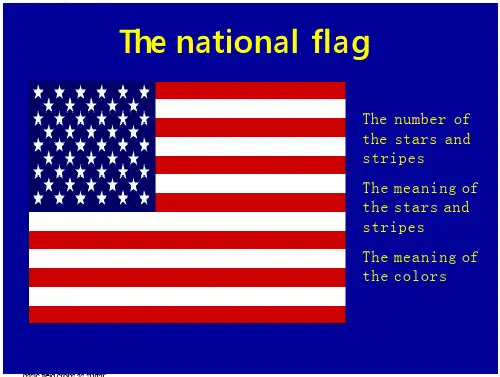
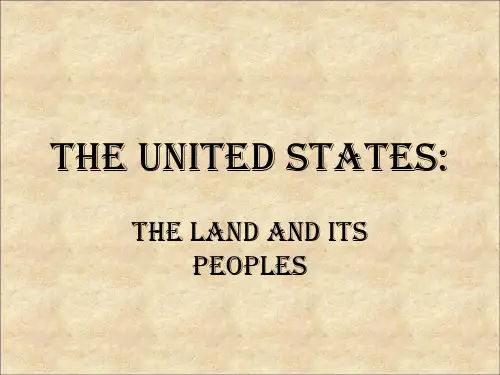
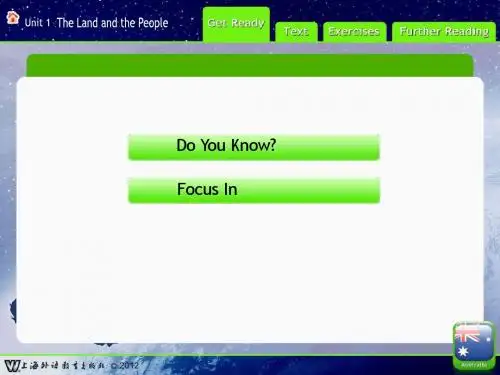
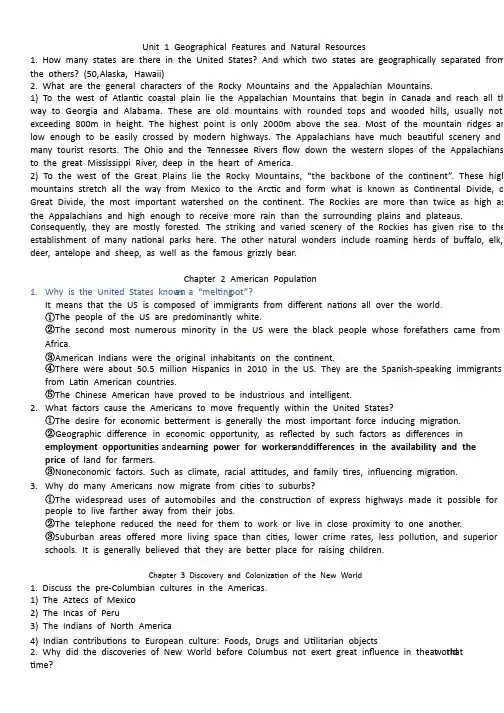

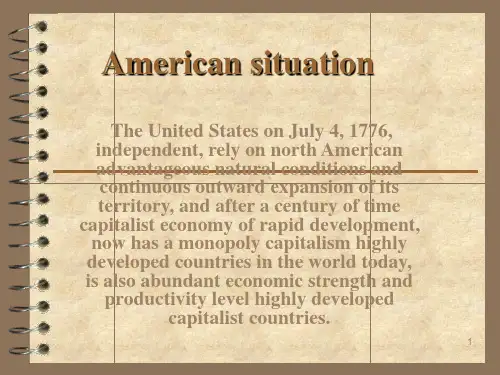
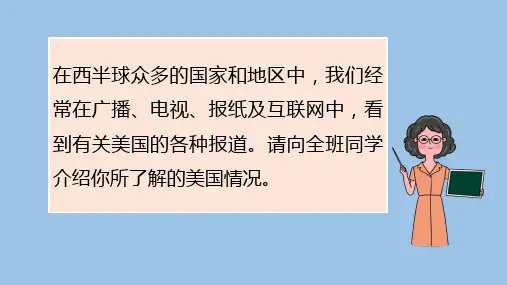
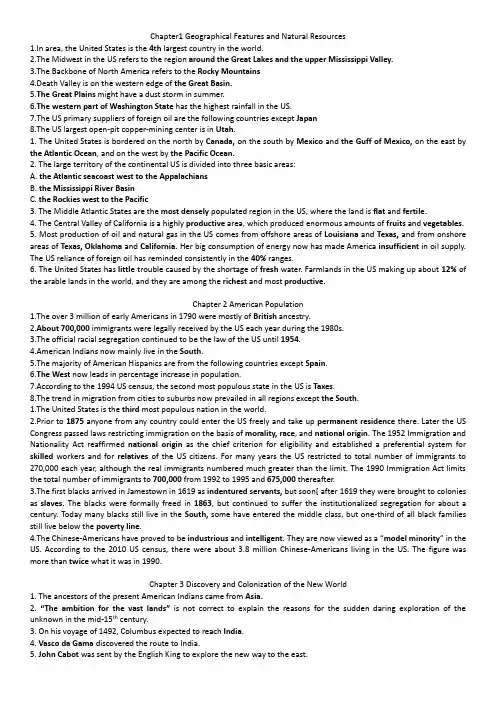
Chapter1 Geographical Features and Natural Resources1.In area, the United States is the 4th largest country in the world.2.The Midwest in the US refers to the region around the Great Lakes and the upper Mississippi Valley.3.The Backbone of North America refers to the Rocky Mountains4.Death Valley is on the western edge of the Great Basin.5.The Great Plains might have a dust storm in summer.6.The western part of Washington State has the highest rainfall in the US.7.The US primary suppliers of foreign oil are the following countries except Japan8.The US largest open-pit copper-mining center is in Utah.1. The United States is bordered on the north by Canada, on the south by Mexico and the Guff of Mexico, on the east by the Atlantic Ocean, and on the west by the Pacific Ocean.2. The large territory of the continental US is divided into three basic areas:A. the Atlantic seacoast west to the AppalachiansB. the Mississippi River BasinC. the Rockies west to the Pacific3. The Middle Atlantic States are the most densely populated region in the US, where the land is flat and fertile.4. The Central Valley of California is a highly productive area, which produced enormous amounts of fruits and vegetables.5. Most production of oil and natural gas in the US comes from offshore areas of Louisiana and Texas, and from onshore areas of Texas, Oklahoma and California. Her big consumption of energy now has made America insufficient in oil supply. The US reliance of foreign oil has reminded consistently in the 40% ranges.6. The United States has little trouble caused by the shortage of fresh water. Farmlands in the US making up about 12% of the arable lands in the world, and they are among the richest and most productive.Chapter 2 American Population1.The over 3 million of early Americans in 1790 were mostly of British ancestry.2.About 700,000 immigrants were legally received by the US each year during the 1980s.3.The official racial segregation continued to be the law of the US until 1954.4.American Indians now mainly live in the South.5.The majority of American Hispanics are from the following countries except Spain.6.The West now leads in percentage increase in population.7.According to the 1994 US census, the second most populous state in the US is Taxes.8.The trend in migration from cities to suburbs now prevailed in all regions except the South.1.The United States is the third most populous nation in the world.2.Prior to 1875 anyone from any country could enter the US freely and take up permanent residence there. Later the US Congress passed laws restricting immigration on the basis of morality, race, and national origin. The 1952 Immigration and Nationality Act reaffirmed national origin as the chief criterion for eligibility and established a preferential system for skilled workers and for relatives of the US citizens. For many years the US restricted to total number of immigrants to 270,000 each year, although the real immigrants numbered much greater than the limit. The 1990 Immigration Act limits the total number of immigrants to 700,000 from 1992 to 1995 and 675,000 thereafter.3.The first blacks arrived in Jamestown in 1619 as indentured servants, but soon[ after 1619 they were brought to colonies as slaves. The blacks were formally freed in1863, but continued to suffer the institutionalized segregation for about a century. Today many blacks still live in the South, some have entered the middle class, but one-third of all black families still live below the poverty line.4.The Chinese-Americans have proved to be industrious and intelligent. They are now viewed as a “model minority” in the US. According to the 2010 US census, there were about 3.8 million Chinese-Americans living in the US. The figure was more than twice what it was in 1990.Chapter 3 Discovery and Colonization of the New World1. The ancestors of the present American Indians came from Asia.2.“The ambition for the vast lands”is not correct to explain the reasons for the sudden daring exploration of the unknown in the mid-15th century.3. On his voyage of 1492, Columbus expected to reach India.4. Vasco da Gama discovered the route to India.5. John Cabot was sent by the English King to explore the new way to the east.6. New York was not founded first by the English.7. The breadbasket colonies include the following ones except Virginia. (New York, Pennsylvania, Maryland)8. The last one of the 13 colonies was Georgia, which was established in 1733.1. In 1488 Bartholomew Diaz, sailing under the Portuguese flag, went to the Cape of Good Hope at the southern Africa. In 1492 Christopher Columbus, financed by rulers of Spain sailed west across the Atlantic Ocean and discovered the islands of the Caribbean. He was convinced that he had found the continent of Asia.2. The South Africa was discovered by Amerigo Vespucci who showed the land he arrived in was a new continent. Before long the land was named America after his name.3. Jamestown, the first permanent English settlement, was founded in 1607. In 1620, Pilgrims and others arrived in Plymouth, Massachusetts. They drew up “Mayflower Compact”4. By 1775, the 13 colonies in North America could be classified as the following three kinds. Specify how the governors were chosen in each.a. Royal: appointed by the English Kingb. Proprietary: chosen by proprietorsc. Self-governing: elected by residents5. Because the New England colonies were difficult of farming, they become a center for fishing and shipbuilding. The middle colonies were known as the breadbasket, which produced wheat and potatoes as the major staple. The southern colonies developed a plantation system. The main crop in the South was tobacco. Much later, cotton became important crop.Chapter 4 American Revolution1. There was a great change in policy towards the 13 colonies after 1763.2. The Stamp Act of 1765 first set a large scale of opposition in the colonies.3. The Tea Act of 1773 was passed by the British Parliament in order to help the British East India Company.4. The First Continental Congress was attended by the representatives from all the colonies except Georgia.5. The first shot of the American War of Independence was fired in Lexington.6. Thomas Paine’s Common Sense urged the American colonists to declare their in dependence.7. The principal author of the Declaration of Independence was Thomas Jefferson.8. The victory at Saratoga was considered as the turning point of the War of Independence.1. During the colonial days the English ruling class did everything they could to control the development of the colonial economy. The colonies in North America were supposed to complement and not compete with English industry.2. Within the five years from 1763 to 1767 after the war with France, the British government adopted several measures to extract more money from colonies. The Sugar Act of 1764 and the Stamp Act of 1765, for example, laid taxes on certain imports and numerous articles in America to help pay for the costs of British government in the colonies.3. The Sons of Liberty was formed in 1765 to organize the opposition to the Stamp Act. They favored to take violent action to the stamp collectors.4. The first Continental Congress was held in Philadelphia in Sep.1774. The majority of the representatives still favor to take peaceful means to settle the quarrel with the British. They agreed to refuse to buy English goods, hoping in this way to force the British government to give in to their demands. This united action could be called boycott.5. The Declaration of Independence was signed on July 4, 1776. Karl Marx once called it “the first declaration of the rights of the individual”.6. The American War of Independence lasted 7 years. The fighting was actually ended in 1781, but the final treaty between Britain and the United States was signed in Paris in 1783. The boundaries of the United States were fixed roughly from the Atlantic Ocean to the Mississippi River on the west and from the Great Lakes on the north to Spanish Florida on the south. The direct social change brought about by the American Revolution was the emancipation of slaves who fought against the British.Chapter 5 the Confederation and the Constitution1. The confederation created in 1781 was a very loose union of states.2. James Madison was called the Father of the US Constitution.3. The Constitution was frames on the following ideals except that the new government should impose its authority on the people through states.4. Those who supported the Constitution and preferred a strong national government were called Federalists.5. Nine States were needed to ratify the Constitution.6. “They spell out the people’s right” is incorrect to comment on the Federalist Papers.7. The amendment of the Constitution requires the approval of at least three-fourths of the states.8. When the Second War of Independence broke out in 1812, the US president was James Madison.1. Under the Articles of Confederation the national government consisted of only a legislature; it had no separate executive and judicial divisions. The state government was left the exclusive powers to regulate commerce and to tax their citizens.2. The Constitutional Convention was held in Philadelphia in 1787. Fifty-five delegates from all states except Rhode Island attended the opening session. The president of the convention was George Washington.3. The Antifederalists opposed the constitution and preferred a more decentralized federal system of government.4. George Washington was elected unanimously as the first US President in 1788. The first Vice-President was John Adams, and the first Secretary of Treasury was Alexander Hamilton, and the first Secretary of State was Thomas Jefferson.5. the most glorious achievement of Jefferson as President was the Louisiana Purchase, which was about 828,000 square miles. This Purchase doubled the area of the then United States.6. The War of 1812 is also called the Second War of Independence. This war lasted three years and ended in another American victory. An important result of the war was the strengthening of national unity and patriotism. And it was after this war that the US was able to make the change of a semi-colonial economy into a really independent national economy.Chapter 6 American Expansion and the Civil War1. The Monroe Doctrine had the following features or ideas except Latin America for Europeans.2. The US continental expansion was almost complete by 1848.3. Cotton became the most profitable crop in the South mainly because of the Whitney’s cotton gin.4. In 1854, the Republican Party was founded by some abolitionists.5. In his inaugural address in 1861, Lincoln showed clearly that he would not abolish slavery immediately but to preserve the Union.6. “It immediately freed all slaves living in the United States” about the Emancipation Proclamation is not accurate.7. the most important advantage the North had over the South in the Civil War was its industrial superiority.8. An advantage the South had over the North was its superior military leadership.1. The essence of the Monroe Doctrine was “America for Americans” which later became the cornerstone of the US foreign policy.2. The US expansion to the west may be treated in three stages;A. the settlement of the region between seaboard states and the Mississippi RiverB. the settlement of the Louisiana Territoryc. the occupation of the far Southwest.3. The great majority of dwellers in Louisiana Territory were the descendants of the French pioneers. They settled mainly in two cities: St. Louis and New Orleans.4. Oregon Territory was settled between Britain and the United States in 1846. Its boundary on the north was fixed at the forty-ninth parallel of north latitude.5. Under Missouri Compromise, Missouri was admitted as a slave state, but the balance of political power maintained by admission of Maine as a free state. In addition, slavery was to be prohibited in the rest of Louisiana Territory north of the line36°30’ parallel.6. In 1862, the federal government took two revolutionary measures: (1) Homestead Act and (2) Emancipation proclamation.7. In July 1863 came the turning point of the war at Gettysburg. Here the Confederate army under the general Robert E. Lee was defeated. The battlefield was made a national cemetery, where Lincoln gave his famous speech, the Gettysburg Address, on November 19, 1863.8. In 1865, the Thirteenth Amendment to the US Constitution was adopted, which abolished slavery throughout the United States.Chapter 7 Reconstruction and the Birth of US Imperialism1. The first US president who faced impeachment proceedings was Andrew Johnson.2. The radical Reconstruction was ended under the President Rutherford B. Hays3. Gold was discovered in California in 1848.4. The first transcontinental railroad in the US was completed in 1869.5. Telephone was invented in 1876 by Alexander D. Bell.6. The value of manufactured goods in the US was worth twice as that of her agricultural products by 1900.7. The first imperialist war, the US—Spanish War, broke out in 1898.8. After the US—Spanish War, the US acquired all the following areas except Cuba (Puerto Rico, Guam, the Philippines)1. The Reconstruction Acts divided all the former Confederate states, except Tennessee, into five military districts and each was put under the control of a Northern army officer. The officer had the power to keep order and to enforce martial law if necessary.2. During the Reconstruction period many Northerners moved to the south .Whatever their motives, these Northerners came to be called carpetbaggers because they were said to have brought all their belongings to the South in a small, cheap suitcase made out of a carpet like material.3. During the Reconstruction the Southern whites who supported the radical reconstruction and joined the Republican Party were called scalawags. They were considered as traitors by the Southern Democrats.4. The KKK, founded in Tennessee in 1866, was a secret society for restoring white supremacy and driving blacks out of politics.5. During Theodore Roosevelt’s presidency the US got control of Panama Canal.Chapter 8 World War I and the Depression1. By the beginning of the 20th century the country that took the first place in economy in Europe was Germany.2. When the First World War began, President Wilson immediately called upon the American people to observe strict neutrality.3. The US joined the First World War in 1917.4. Wilson’s Fourteen Points did not include the point of creation of an international peacekeeping force.5. “Only the rich could afford new consumer goods” about the US in 1920s is not true.6. In responding to the Depression, President Hoover thou ght that the basic role of the Government was to “create conditions favorable to the development of private enterprises”.7. The agricultural Adjustment Act was an attempt to deal with the farmers’ problem of overproduction.8. “It reduced the commodity prices by limiting production and devaluing the dollar” is not right to comment on the New Deal.1. The First World War was waged between two groups of imperialist powers: the Allies and the Central European Power.2. The direct cause that made the US declare war on Germany in 1917was the Germany’s unlimited campaign.3. The major triumph for Wilson at the Paris Peace Conference was the formation of the League of Nations.4. The United States didn’t join the League of Nations because the US Senate refused to approve the Treaty of Versailles.5. Three major treaties were concluded at the Washington Conference:(1) The Four-Power Treaty, respecting the status quo in the Pacific.(2) The Five-Power Treaty, on naval arms apportionment.(3) The Nine-Power Treaty, guaranteeing the independence and integrity of China in appearance, but actually a public international affirmation of the Open Door policy.6. The Nineteenth Amendment to the US Constitution was adopted in 1920, which granted women the right to vote.7. The Great Depression started with the sudden collapse of the Stock Market in New York in October, 1929. This economic distress extended to Europe, Asia, Africa, Australia and South America.Chapter 9 American During and After World War II1. Between 1935 and 1939, American foreign policy included all of the following except active intervention to prevent aggression.2. The US formally entered the Second World War in 1941.3. Normandy Landing took place on June 6, 1944.4. At Yalta Conference, in Feb. 1945 did Roosevelt, Churchill and Stalin agree to call a conference of all the United Nations in San Francisco in April 1945.5. The post-World War II program of economic assistance to Western Europe was known as Marshall Plan.6. Dr. Martin Luther King, Jr., advocated the philosophy of nonviolence.7. Thousands of American soldiers were sent to Vietnam under the President Lyndon B. Johnson.8. The formal diplomatic relation at the ambassadorial rank between China and the US was established under the President Carter.1. The cash-and-carry policy allowed US citizens to sell certain no prohibited goods to belligerent nations as long as thosegoods were not transported on American ships.2. Lend-Lease Act enabled any country whose defense the President considered vital to that of the US to receive arms and other equipment and supplies by sale, transfer, exchange, or lease. F.D. Roosevelt explained the Act would make the US the arsenal of world democracy.3. Civil rights involve government protection of individuals against discrimination based on their race,religion nation origin, gender, age, and other factors. Dr. Martin Luther King, Jr. was honored for his effort to fight discrimination. In 1964, he won the Nobel Prize for peace.4. Star Wars program was proposed by President Reagan in 1983. The program seeks to construct a defensive “shield” against incoming missiles. The shield would be made of laser and electronic devices that would destroy such missiles launched to attack the US.5. In 1990, President Bush ordered Operation Desert Storm to punish Iraq, more than 200000 US troops were sent to Saudi Arabia, and the US navy blocked all oil exports from Iraq and all imports except food.6. Under Clinton, the US enjoyed an economic growth for nine consecutive years. This phenomenon, hardly seen before, has been termed the “new economy” by some. The fundamental reason for it is that American economic structure went through essential changes because of the promotion of scientific and technological progress.Chapter 10 the Federal System and Congress1. The power of the state in the US is actually from both B and C. (the state constitution, the US Constitution)2. The supreme law of the United States includes all the above three.3. The terms of the senator and representative are six and two years respectively.4.”The 17th Amendment (1913)” provided for the direct election of senators.5. Certain presidential appointments must be approved by a majority vote in the Senate.6. All revenue or tax bills must be originated in the House.7. The Speaker of the House is second in line in presidential succession.8. In the House, the power to decide when the full House will hear the bill is vested in the Rules Committee.1. Federalism means the division of powers by a constitution between the central government and state government. It operates only on two levels, the national and the states. Units of government within a state enjoy no independent existence.2. Separation of powers in the United States means not only allocating legislative power to Congress, executive power to President and judicial power to the Supreme Court, but also giving each branch constitutional and political independence and checks and balances that ensure each of the three branches a sufficient role in the actions of the others.3. According to the Constitution, members of the House of Representatives must be25years old and must have been citizens for 7 years. Senators must be at least 30 and must have been citizens for 9 years.4. The Vice President is officially the presiding officer and is called the president of the Senate. In fact he seldom appears in the Senate chamber in this role unless it appears that there might be tie vote in the Senate. In such instances, he casts the tiebreaking vote. To deal with day-to-day business, the Senate chooses the president pro tempore.5. A senator who wants to delay action on a bill or kill it altogether may use a tactic called a filibuster. It can be cut off only through cloture.6. Lobbying is part of the citizen’s right to petition government in the US. Now there are thousands of lobbyists in Washington D.C. Their influence in making the US policy is so great that some people call them “the third house”.Chapter 11 The President and the Judiciary1. The 22nd Amendment in following limits the President to two successive terms only.2. The American President has all the following powers except declaring war on another country.3. The president’s major appointments should be approved by the Senate.4. “It requires the approval of Congress” is not correct to explain the executive agreement.5. The President’s veto can be overridden by two-third votes in both houses.6. The federal courts that regularly employ grand and petit juries are the district courts.7. The highest authority of the Supreme Court is to interpret the US constitution.8. The case involving copyright, trademark, counterfeiting, and bank robbery are usually first tried in the federal district courts.1. By law any natural-born American citizen of and over 35 years of age and of being a resident within the United States for 14years can run for the President. The duly elected and duly qualified president-elect takes office on the20th of January following his election.2. The war powers resolution (1973) requires the President to consult congress and withdraw troops after sixty days unless Congress specifically approves the continued deployment of troops.3. A federal law gave President an item veto in 1996, which is an authority to reject specific sections of a bill without having to veto the entire bill.4. The Supreme Court has the power to examine the bills passed by Congress and policies made by President, and declare them unconstitutional and thus abolish them. John Marshall, the most famous chief justice in American history called this power of interpretation judicial review5. There are three federal court levels: 1) the district courts 2) the courts of appeal 3) the Supreme Court. All the judges of federal courts are appointed by President with the consent of the Senate. The state court system also has a hierarchy of three levels: 1) superior courts, 2) appellate courts, 3) a state supreme court. The state court judges are usually elected. The term of the country court judges is usually four years. And the judges in higher state courts usually sever eight or twelve years for one termChapter 12 Political Parties and Elections1. The emblem of the Democratic Party is donkey.2. The first Democratic President was Thomas Jefferson.3. The first Republican President was Abraham Lincoln.4. The only Democratic President who served two separate terms between the end of Civil War and 1912 was Grover Cleveland.5. The presidential candidate of the major party is nominated at the national convention.6. In the presidential election year the American voters vote on the Tues, after the 1st Mon.7. The number of the presidential electors in each state is equal to the number of its senators and Representatives.8. The American President is actually elected by presidential electors.1. Two factions emerged during the ratification of the US Constitution. One group was called Federalists led by Alexander Hamilton. They favored business development, a strong national government, and a loose interpretation of the Constitution. Another group led by Thomas Jefferson was called Democratic-Republicans. They called for a society based on small farms, a relatively weak central government, and a strict interpretation of the Constitution. The roots of today’s Republican Party lie in the Federalists, while the Democrats can trace their beginnings back to Antifederalists or Democratic-Republicans.2. In general, Democrats traditionally have supported workers and minorities, while the Republicans are known for known for their support of business and conservative positions on social issues.3. Before 1971 the only state that gave 18-year-old the right to vote was Georgia; all other states set the age at 21. In 1971 the 26th Amendment to the Constitution lowered the voting age to 18.4. The voting percentage now is very low in the United States. In general older people with more education and high income tend to vote, while the youth, especially aged 18 to 21, has the lowest voting percentage in the Unites States.5. The candidate with the most votes in a state wins all of that state’s electoral votes. This is known as the “winner-take-all” principle. The candidate who wins the majority of the 538 Electoral College votes will be the US President in the next four years.。
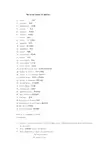
The United States of America1.plain 平原2.plateaus 高原3.predominant 占优势4.glacier 冰川5.tropical 热带的6.borough 行政区7.refine 提炼8.census 人口普查9.immigrant 移民10.ethnic 种/民族的11.amalgamate 同化12.strait 海峡13.reservation 居留地14.famine 饥荒15.assimilation 吸收16.Great Plain 大平原17.Arctic Ocean 北冰洋d subtropical zone 温和的亚热带气候19.Statue of Liberty 自由女神像20.center of oil-refining 炼油中心U.S.Census Bureau 美国人口普查局21.nation of immigrant 移民国家22.Bering Strait 百令海峡23.Great Famine 大饥荒24.melting pot 大熔炉25.Immigration Act 移民法案26.Gulf of Mexico 墨西哥湾27. New Deal 新政28.abolition of slavery 废奴29.Emancipation of proclamatio解放宣言30.the Allies 同盟国31.the U.S.hegemony 美国霸权Chapter 1. Geography & PeopleI.Geography1.Location. In the central part of North of America,It’s bordered by Canada on the north,Nexicoon the south.2.Area, 95000000 square kilometers3.Three geographical ares: the eastern partThe western partThe Great Plain4.Ist mountain: the Rocky Mountains落基山5.Ist river: The Mississippi River,3780kilometers6.Ist lake: lake Superior 苏必利尔湖7.Ist fall: Niagara Fall尼亚加拉大瀑布8.Climate:mild subtropical zone(温和的亚热带气候)9.Major cities: Ist. New York2nd. Los Angeles3rd. Chicago10.Capital: Washington D.C.11.Religions:Christian(Protestant新教徒57%)Catholic 28%IslamBuddist 佛教II.People1.Population: 300million (in 2006)2.Race: white people 74.7%Blacks 12,1%Asians 4.3%Others 6%3.Nation of immigrantsChapter 2. HistoryI.America in the Colonial Era(1607-1776)In 1492,Christopher Columbus,who was financed by the Spanish King and Queen, is believed to have discovered America.Since then,many Europeans set food on this large continent, they called it “the New World”.1)Jamestown 詹姆斯城:The 1st successful English colony was found at Jamestown,Virginia,in 1607 bya team from the London Company.2)Pilgrim Father清教徒前辈移民:in 1620,a group of Puritans including poor farmers amd workers,who were later called the Pilgrim Father,sailed for Virginia on a ship called the Mayflower. They had been persecuted in England because they refused to abide the rules of the Church of England(英国教会)。
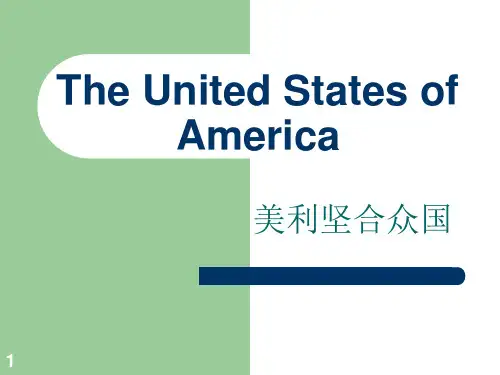
Unit 1 Geographical Features and Natural Resources1. How many states are there in the United States? And which two states are geographically separated from the others? (50, Alaska, Hawaii)2. What are the general characters of the Rocky Mountains and the Appalachian Mountains.1) To the west of Atlantic coastal plain lie the Appalachian Mountains that begin in Canada and reach all the way to Georgia and Alabama. These are old mountains with rounded tops and wooded hills, usually not exceeding 800m in height. The highest point is only 2000m above the sea. Most of the mountain ridges are low enough to be easily crossed by modern highways. The Appalachians have much beautiful scenery and many tourist resorts. The Ohio and the Tennessee Rivers flow down the western slopes of the Appalachians to the great Mississippi River, deep in the heart of America.2) To the west of the Great Plains lie the Rocky Mountains, “the backbone of the continent”. These high mountains stretch all the way from Mexico to the Arctic and form what is known as Continental Divide, or Great Divide, the most important watershed on the continent. The Rockies are more than twice as high as the Appalachians and high enough to receive more rain than the surrounding plains and plateaus. Consequently, they are mostly forested. The striking and varied scenery of the Rockies has given rise to the establishment of many national parks here. The other natural wonders include roaming herds of buffalo, elk, deer, antelope and sheep, as well as the famous grizzly bear.Chapter 2 American Population1.Why is the United States known as a “melting pot”?It means that the US is composed of immigrants from different nations all over the world.①The people of the US are predominantly white.②The second most numerous minority in the US were the black people whose forefathers came fromAfrica.③American Indians were the original inhabitants on the continent.④There were about 50.5 million Hispanics in 2010 in the US. They are the Spanish-speaking immigrantsfrom Latin American countries.⑤The Chinese American have proved to be industrious and intelligent.2.What factors cause the Americans to move frequently within the United States?①The desire for economic betterment is generally the most important force inducing migration.②Geographic difference in economic opportunity, as reflected by such factors as differences inemployment opportunities and earning power for workers and differences in the availability and the price of land for farmers.③Noneconomic factors. Such as climate, racial attitudes, and family tires, influencing migration.3.Why do many Americans now migrate from cities to suburbs?①The widespread uses of automobiles and the construction of express highways made it possible forpeople to live farther away from their jobs.②The telephone reduced the need for them to work or live in close proximity to one another.③Suburban areas offered more living space than cities, lower crime rates, less pollution, and superiorschools. It is generally believed that they are better place for raising children.Chapter 3 Discovery and Colonization of the New World1. Discuss the pre-Columbian cultures in the Americas.1) The Aztecs of Mexico2) The Incas of Peru3) The Indians of North America4) Indian contributions to European culture: Foods, Drugs and Utilitarian objects2. Why did the discoveries of New World before Columbus not exert great influence in the world at that time?Because Europe was then poor and politically fragmented, It was beset by local wars and civil disorder and largely illiterate. In short, Europe was then incapable of responding to the Norse discoveries.3.Why did so many English people move to the New World in the 17th century?1) The New World was a great and rich land. In the New World there were all those resources necessary for agricultural and industrial development.2)During the reign of Queen Elizabeth I (1588-1603), the English in growing numbers realized that the New World was their best place to make their fortunes, and to worship and live according to their beliefs.3)Some of them might move to America to leave oppressive political institutions, to escape burdensome church duties, to acquire large landholdings or merely to change their general pattern of living. Of course, material gain was a common factor.4. What was the social structure of the 13 colonies?Society in the l3 colonies was like a pyramid.①The top was made up of merchants and landlords.②The base was made up of refugees from Europe, black slaves from Africa. And native Indians.5.Why did not the American Indians become slaves during the colonial days?As for Indians, they could not put up with slavery. If an Indian was enslaved, his fellow tribe members would fight to free him. So the colonialists soon gave up the attempt to use them as slave labor. Instead they seized the land of the Indians and drove them away or killed them.Chapter 4 American Revolution2. What happened on the evening of March 5, 1770?A clash between American colonies and British soldiers took place in Boston.①A group of unemployed laborer attacked a British sentry stationed at the Boston customhouse.②When the British soldiers dispatched to help the sentry arrived, they met a rapidly growing, angry crowd.③Someone gave the command for the soldiers to fire.④Three colonies were killed and several were wounded, two of whom later died.3. How did the colonies react to the Townshend Act?The colonies, however, still rejected the idea that the Parliament in Britain had the right to tax them without consent and reacted to these new duties by refusing to import any of the taxed goods.4. What were the main contents of the Declaration of Independence?①The Preamble, which explains why the Declaration was issued.②A statement of principles of government to which the American people were committed③A list of injustices suffered by the colonists.④A summary of efforts the colonies had made to avoid a break with the mother country.⑤The proclamation is that the “Colonies are Free and Independent States”5. What was the importance of the victory at Saratoga?The victory and Saratoga wa s a turning point of the war. It further heightened the spirit of the Americans, but more importantly it caused action abroad. It was after this battle that the French agreed to join the war against Britain. Later Spain and Holland joined France while most of the other European powers formed an Armed Neutrality to protect their commerce from Britain’s naval power.Chapter 5 the Confederation and the Constitution1. What is confederation?A confederation is a government in which the constituent governments, called states in the US, create a central government by constitutional compact but do not give it power to regulate the conduct ofindividuals.2. Compare the powers of the governments under the Articles of Confederation and the Constitution.3. What does the “check and balance” mean?It means that each branch of government-executive, legislative, or judicial-must exercise distinct powers and be selected in a distinct way, and that each branch must be able to “check and balance” the others if one branch grew too powerful and sought to dominate the others.4. What was the Bill of Rights?It guaranteed freedom of speech, religion, peaceful assembly, and the press; the right to bear arms; freedom from unreasonable search; and the right to the protection of certain legal procedures known as the due process of law.5. What were the chief causes of the War of 1812?①The British were not reconciled to the loss of their thirteen colonies. Using Canada as the base, they always challenged to battle with the young Republic.②This anger reaches its peak in 1807 when one British warship attached and boarded in American ship, killing and wounding 21men and impressing four sailors.③Jefferson persuaded Congress to pass an Embargo Act, which forbade all ships, except foreign ones without charge, to leave American ports.Chapter 6 American Expansion and the Civil War1. What was the importance of the Monroe Doctrine?The essence was” America for Americans”, which later became a cornerstone of the US foreign policy. As the New world developed in the years ahead this Doctrine became more meaningful and was strengthened by a broader interpretation to meet the needs of an energetic and ambitious United States.2. What were the basic causes of the Civil War?Two different social-economic systems existed side by side in the United States.In the South slavery was the foundation of the economic system while in the North industry and commerce were the main character of its economy. The swiftly growing industries in the North required the restriction of slavery as well as an expanding territory in order to provide capitalist production with raw materials, markets and abundant labor supply.The slave economy in the South was an obstacle to industrial growth and expansion. This economic antagonism led to increased conflicts between the North and the South.3. What was the doctrine of the “popular sovereignty”?This doctrine means that the inhabitants of the new territories can decide the question of slavery for themselves. In appearance, it seemed fair, but in actual practice, as far as slavery was concerned, the doctrine did not work.4. How do you comment on the American Civil War?The outcome of the war placed the northern capitalists in solid control of the federal government of the US capitalism. In 1865, the Thirteenth Amendment to the US Constitution was adopted, which freed all slaves throughout the United States.Chapter 7 Reconstruction and the Birth of US Imperialism1. What is the 10 percent plan?The plan provided that as soon as 10 percent of voters in any state had taken the oath of loyalty, they could form their own government and would be entitled to the recognition of their state by the president of the United States.2. Why was Andrew Johnson impeached by the House?In March 1867, Congress passed two Acts that took away two presidential prerogatives: the right to remove Cabinet members and the right to remove army officers under his command.To test the constitutionality of the Act, President Andrew Johnson removes Edwin M. Stanton, the Secretaryof War, from office in1869, who was the only remaining Radical in Johnson’s Cabinet.He thus walked into troubles with the radicals. Later the House voted to impeach the President.3. After the Reconstruction, how were the civil rights of the Blacks in the South?①Voters must be able to read and write;②Voting taxes were introduced;③The whites also took steps to segregate the blacks and two separate societies emerged in the South.4. Why did the US have a rapid industrial growth after the Civil War?①The vast industrial development began with the opening the West.②Speeding this process of western settlement were the railroads.③Science and technology were also greatly marching forward.④The basic industry of the nation, iron and steel, also developed rapidly after the Civil War.⑤The oil industry also developed rapidly.⑥During the latter part of the 19th industry, industrial expansion in America went ahead rapidly.⑦There was a clear indication of rapid concentration of capital.6. What was the “Open Door Policy”?The so-called “Open Door Policy”which demanded that all the imperialist powers should enjoy equal chance in China as freely as other aggressors.。
英美文化与概况British and American Studies( American Part )Unit One大学英语第一教研室余非2011年2月Unit 1 The United States and American PeopleContents1.Geographical Position and Area of Land2.Rivers and Lakes3.American People1. Geographical Position and Area of LandThe full name of the United States of America (USA) is sometimes abbreviated to the United States (US) or simply to America.With the fourth largest territory in the world , the United States is the world’s largest economy and its development involved many contributing factors.Rich land resources with varied geographical conditions is an important factor that contributes to America’s development .The territory of the United States includes Mainland America, anumber of islands and some overseas territories.The United States consists of 50 states with a total land area of about 9.4 million square kilometers . Two of the 50 states are separated from the continental United States. They are Alaska and Hawaii.Mainland America extends about 5,000 kilometers from east to west, and about 2,500 kilometers f rom south to north. Its coastline is about 20,000 kilometers.Neighbors of the United States: North:Canada; South:Mexico; West:Pacific Oceans;East: Atlantic Ocean.Mainland America can be generally divided into three basic geographical areas or surface region :A)The Atlantic Seacoast and the Appalachian MountainsB)The Mississippi River ValleyC)The Rockies and the Pacific Ocean●Atlantic Seacoast and Appalachian MountainsThe Atlantic Seacoast is a strip of fairly level country between the Atlantic and the Appalachians. It is the country of the first European immigrants and the 13 original states.●The Mississippi River ValleyThe Mississippi River Valley, also known as the Central Plain , consists of the large area between the Appalachian on the east and the Rocky Mountains on the West.The sediment of the rivers makes the soil of the region very rich, thus, the central Plain enjoys the name of “Barn of America”.●The Rockies and the Pacific OceanThe RockiesOn the west side of the Great Plain are Rocky Mountains, also known as “the backbone of the continent”. It stretches from Mexico into Wyoming and interrupted by Wyoming Basin.Rocky Mountains are well-known for their striking and varied scenery : Yellow Stone National Park, Grand Canyon, Las Vegas, Death V alley。
Pacific CoastThe Mountains along the Pacific coast are called the coast Ranges. They are of low elevation and gentle slope.Main Valleys:✧Central Valley -- Lush farm , numerous orchards✧Willamette Valley -- (ditto)✧Silicon Valley --- center of America’s electronic industry2.Rivers and LakesThe Mississippi River , also known as “Old Man River”, is the most important and largest river in the United States. It flows about 6,400 kilometers from its northwestern source in the Rockies to the Gulf of Mexicao.Other rivers in the United States: the Missouri Rive, the Ohio River, the Tennessee River, the Colorado River. The Rio Grande River (a bondary river between Mexico and the United States),the Potomac River, the Hudson River.The most importants lakes in America are the Great Lakes, which are composed of 5 lakes. Of these five lakes only one, Lake Michigan, belongs to America completely while the other four are shared with canada.The five lakes slope downward towards the east. Lake Erie is ove 100 meters higher then Lake Ontario and the river that connects them is called Niagara. The steep drop in elevation gives birth to the Niagara Falls, which attracts large numbers of visitors from around the world.3.American People●The Indians and Indian CivilizationThe story about the American people involves the native Indians as well as immigrants from all over the world: White People: 78% of the total ; Other ethnic group: 22% of the total, including: African-Americans, Hispanics, Native Americans (Indians), Asians .The Indian people, also known as the first Americans, had developed three great civilizations in North America before the arrival of European clonoists. They are Maya civilization , Toltec civilization and Aztec civilization●Immigration into AmericaThe United States is a nation created by immigrants, and immogrants continue to affect Ameirican society significantly today. Most of the early immigrants were from Europ, but now most of the new immigrants are from Asia and Latin America.●Ethnic GroupsLarge numbers of immigrants from all over the world turned the United States into a nation over 100 ethnic groups. An ehtnic group is made up of people with some common characeristics that make them different from other ethnic groups.1) European AmericansThe mojority of Americans are Caucasians, or informally called “white” people , who account for about 78% of the total US population . They are immigrants or descendants of immigrants from European nations. They share similar values and most of them believe in Christianity.Most of the early immigrants in 13 colonies were English protestants and came to theland for freedom of religious belief.About 1/3 of Americans have ancestors from Britain. They are the most influential and wealthiest in America because American culture is based on the Anglo-Saxon culture..2) African AmericansAfrican Americans , or people informally called black Americans , account for 12% of the total US population. They were called “unwilling immigrant” because they were victims of the traffic in slaves.Before the Civil War, over 90% of black slaves were in the south of United States. They were treated like animals and denied human rights.Even after the abolition of slavery, blacks were still thought to be inferior human beings and suffered from open or covert discrimination.After World War II, “ civil right movement ” waged by black people drew great attention and changes began to take place.The US Congress passed the Civil Right Act in 1964. It protected blac k people’s right to vote and enjoy the same education and employment opportunities as white people.3) Hispanics/LatinosHispanics, or Latinos, are Spanish-speaking people from Latin America, which was dominated by the Spanish Empire.It is estimated Hispanics make up 10% of the total US population, and many of them are mixed blood.The majority of Hispanics are Mexican-Americans, and most of them are manual workers because of lacking in education and skills.4) Chinese AmericansThe early Chinese-Americans worked as gold miners and laborers in railway construction during mid-19th centuryAs the cheap labor provided by the Chinese laborers took job away from American workers, Chinese Exclusion Act was passed in 1882 to stop Chinese immigration.Although Chinese-Americans nowadays still suffer from racial discrimination in some cases, they have proved to be industrious and intelligent. Most of them are well-educated and have high-income positions.5) Jewish-AmericansDuring the Second World War, many Jews went to America to escape the holocaust started by Hitler’s government. Today, the number accounts for 2% of the US population.The Jews have been reputed for being skillful financiers or money-lenders. Many Jews in America are successful businessmen maintaining close relationship with politicians.The Jews’ influence on US politics prompts the US government to help Israel when there is a need do so.●Melting Pot or MosaicMelting Pot ?As immigrants from different regions and cultures came to live in the United States, their old ways of life melt away, and they became part of the American culture. The United States was thus compared to a big pot of soup that had bits of flavor from different cultures. Mosaic ?Today, some people compare America to a mosaic because many new immigrants refuse togive up their cultural distinctiveness. Often groups of people from the same culture live together in their own communities. Therefore, America is a picture of many distinctive colors, and the color do not fully mix with each other.。